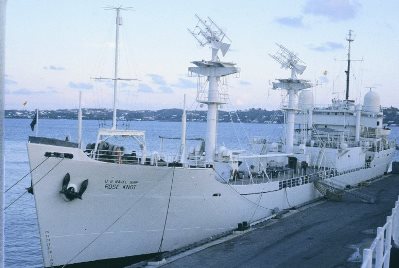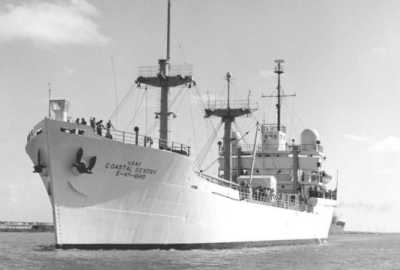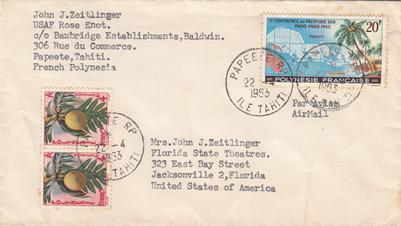Space Cover #473: Missile Range Instrumentation ShipsThis is the only ship's cover for a Missile Range Instrumentation Ship known to this author during Project Mercury even though it was posted prior to its mission for Project Mercury astronaut Gordon Cooper. His mission also is the final mission of Project Mercury. The author believes that the operations were classified for USNS Rose Knot and USNS Coastal Sentry and this may have restricted mail being sent from these two ships.
Concerning Missile Range Instrumentation Ships, this is what we know, with special thanks to Range Engineer, Dan Kovalchik, and his enlightening article on these ships, "The Rocket Ships" giving us a brief history of the work they performed in this period.
By 1959, the Cape's missile programs had been pushing the technology envelope for nine years and digital telemetry systems began to outstrip their analog counterparts. Furthermore, the availability of ocean-bottom contour maps in concert with the new LORAN system and a top-secret Ships Inertial Navigation System, solved the navigation problem that had limited the tracking radar dishes to land stations. Ships were already carrying radar for collision prevention and coastal navigation. The improved navigation systems, however, gave the tracking radars the data they needed to pinpoint their targets.
Suddenly, project leaders found new uses for range instrumentation ships and began clamoring for ships of their own. This led, in rapid succession, to the conversion of another series of World War II vessels: a Liberty ship into the American Mariner; a Victory ship into the Twin Falls Victory, and two troop transports into the General Hoyt S. Vandenberg and the General H.H. Arnold.
And then, yet another customer appeared. The year was 1960, and NASA, because of something called Project Mercury, was building a tracking station network of its own. The Air Force contributed the C1-M-AV1s Rose Knot and Coastal Sentry, and NASA filled the ships with new instrumentation, including a "command" system, which enabled the ship to transmit commands to the spacecraft, and an "acquisition aid" system, which homed in on the spacecraft's beacon and guided the command and telemetry antennas.
Manned spaceflight had arrived, but despite the advances in technology, NASA still could not guarantee communication between the Cape's mission control center and the remote sites, so communication with the spacecraft was handed off to the network of tracking stations and ships. For each launch, every ship hosted a capsule communicator (CapCom) and at least two flight surgeons to monitor spacecraft systems and to help astronauts with health emergencies.
Though the doctors were intended to serve the spacecraft's passengers, one surgeon aboard the Coastal Sentry for John Glenn's flight performed an emergency appendectomy on a crewman. The operating room? A converted mess hall.
At least two astronauts served as CapComs. The Rose Knot hosted Alan Shepard during Wally Schirra's Mercury 8 flight in October 1962.

For the final Mercury mission, in May 1963, John Glenn manned the Coastal Sentry's console for Gordon Cooper. Glenn's presence proved crucial when Cooper's electrical systems began to fail. Glenn radioed Cooper with the modified procedures and maneuvers for manual reentry, which resulted in Cooper's flawless return.

The ships again showed their value during an emergency that arose in March 1966 during Gemini 8. Dick Bodette, then the Coastal Sentry's operations manager, remembers, "There was always a little thrill when we locked onto the astronauts' signal, but this was the 10th mission for some of us, and maybe a bit of the thrill was wearing off. That all changed when we saw the Gemini's wildly fluctuating beacon and realized the oscillations could only be caused by a tumbling spacecraft." Moments later, astronauts Neil Armstrong and Dave Scott confirmed Bodette's fears.
Armstrong stabilized the craft, but Gemini 8's flight plan was suddenly obsolete. The astronauts' lives depended on receiving a new set of deorbit data, and their only chance for receiving it lay with the Rose Knot and the Coastal Sentry, the only tracking stations in the spacecraft's path. These few minutes of contact proved to be sufficient. Flight controllers invented alternate deorbit plans, and, with the help of a nearby ship that had satellite capability, Bodette's crew received this information and relayed it to the Gemini crew.
Despite the C1-M-AV1s' stellar performance throughout the Mercury and Gemini programs, the ships weren't equipped to handle the next phase of NASA's plan. Instead, NASA budgeteers allocated $90 million to transform three World War II oil tankers into the Vanguard, Redstone, and Mercury. The new ships were double the length and four times the tonnage of the C1-M-AV1s, creating a vastly improved comfort level for 85 crew members and 108 technicians.
The conversion from forgotten derelicts to shiny transports was accomplished courtesy of the Apollo program, which also initiated a sweeping overhaul of both spacecraft and tracking station electronics. One of the most important changes was the satellite communications link, which would finally guarantee clear, constant contact with the mainland. The Apollo ships' navigational aids marked another area of improvement, allowing navigators to fix their position to within an unheard-of 600 feet. This precision, in turn, enabled flight controllers to more accurately identify the location of the spacecraft. Each ship carried improved versions of the standard technologies, as well as a new satellite navigation system, the forerunner of GPS.
For the first time in manned spaceflight, lunar trajectories became part of the equation. The Vanguard, Redstone, and Mercury would gather this data in the initial phases of the flight, but there was a hole in the reentry support. To fill it, the Western Test Range, which was established in 1958 to extend from Vandenberg Air Force Base in California west to the Indian Ocean, donated two of its Victory ships, Huntsville and Watertown, for the upgrades.
Many thanks to Dan Kovalchik for his preserving this incredible information for ships that would have been scraped to becoming a key part of the Project Mercury Program.
— Steve Durst Space Unit, 4379















